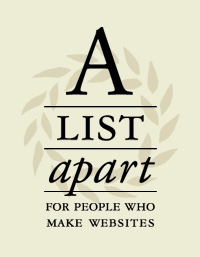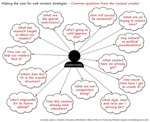Content Strategy: Exclusive interview with Sara Wachter-Boettcher
 This month, we’re focussing on the importance of Content Strategy. This coincides nicely with the launch of a new book titled ‘Content Everywhere’ by Sara Wacheter-Boettcher who is also the editor of A List Apart. We interviewed Sara to talk to you about her new book and explain exactly what content strategy is, how it fits into the User Experience (UX) process and why it’s important for you to have a content strategy.
This month, we’re focussing on the importance of Content Strategy. This coincides nicely with the launch of a new book titled ‘Content Everywhere’ by Sara Wacheter-Boettcher who is also the editor of A List Apart. We interviewed Sara to talk to you about her new book and explain exactly what content strategy is, how it fits into the User Experience (UX) process and why it’s important for you to have a content strategy.
Hi Sara! Please could you tell our readers about yourself and what you do
I’m an independent content strategist, the editor of A List Apart magazine, and a general loudmouth. Right now I live in Lancaster, Pennsylvania, in the heart of Amish country, because my husband has a visiting professorship here. Before that, I lived in Arizona, and before that, Oregon, which I still miss every day.
I work directly with clients or partner with agencies to solve complex content problems, and I spend a lot of time writing articles and speaking at conferences to help other web professionals deal with the complexities of content and how it affects their business.
Congratulations on your new book ‘Content Everywhere’. What is it about?
The idea for book came out of all the hubbub over mobile and responsive design that started in the summer of 2011. I had this realization: The problems that we already had with content—both with managing and maintaining it, and with users being able to find content that was relevant to them—were about to be exacerbated by mobile.
That’s because the way we’ve been conceiving of and creating web content has been in big, monolithic pages—and those pages just wouldn’t hold up against the onslaught of different devices and services that are coming. It just looked like big, broken blobs of stuff. Creating new, separate content for every new device wouldn’t work for long, either—there are just too many to keep up with. Instead, we need to make our content more flexible—more capable of being shifted and moved around however it’s needed—and that comes from structure.
When we break content down according to what it is and what it is trying to communicate, and store it in a way that respects its natural shape and flow, then we can do so much more with it: We can connect it to other content based on shared attributes and relationships. We can reformat and reflow it for different devices. We can mash it up with third parties’ data via an API. So that’s what the book is all about: Showing you how to break your content down and turn it into a flexible foundation, and then showing you all the different types of things that will allow you to do.
Who would benefit from reading your book?
It’s definitely a practitioner’s guide—a book for people who want to work hands-on with content. That includes people in content strategy, editorial, and writing roles, but it’s not limited to them. It’s also for people in IA and UX, who are often tasked with organizing and labeling information. The book helps you take those skills and apply them to a micro plane, within a single piece of content.
What I didn’t expect when I wrote the book was how many people from mobile design and development fields would pick it up because they want to really learn how to deal with content—and that’s been really exciting to see as well.
How does the role of content fit within UX?
You can’t really have one without the other, I don’t think. If you’re trying to design an experience and you don’t think about the content, what exactly are you designing? And if you are thinking about content without thinking about the people who will ultimately read or use it, then what’s the point?
What’s interesting about content strategy work is that it both fits within and outside of typical UX roles, because content has to deal with so many other things: the people and workflows and departmental silos and skillsets inside an organization, the content management system, the relationship between groups like IT and marketing and their ability to communicate and get things done, the ongoing needs of the business and how much content will need to be produced in the long run to serve them. The list could go on.
What are the benefits for those companies that include content in their UX process?
If you don’t think about content, you get delays. You get content that “breaks” the design. You get a beautiful interaction stuffed with defensive and condescending error messages. You get a system that works beautifully, but no one on staff who understands how to care for it—how to update the content effectively, what to do when content needs to archived, what sorts of content are appropriate for the experience in the first place. And so, the benefit of including content considerations in every project and every organization is that you can skip all that mess and wasted time and budget, and deliver something that fits the brand, resonates with users, and smooths the entire process—oftentimes with a lot fewer headaches.
Richard Ingram’s illustration shows ways in which a UX team might collaborate with a content strategist
How would user research feed into content strategy?
Well, it’s really hard to connect with your users and get them to care if you don’t understand much about them. I personally work on user research as often as possible, conducting user interviews, synthesizing analytics data, observing users in action. If I’m not the one conducting the research, I want to hear as much as I can from those who are. The more you can empathize with users and understand what’s important to them, the better you can make your content resonate with them, and also the more you can avoid the lure of pretty-yet-meaningless marketing copy, which is shallow and useless.
Could you share one thing people reading this article can do right now to improve their content?
Just go look at it—really look at it. What are all the things you’re putting out there? Do they reflect the organization you want to be? Do they sound human and relatable? Can thou figure out why they’re there? How much are you publishing, anyway, and for whom? Every piece of content you put out there takes time, money, and resources away from your organization. Ask yourself whether it’s helping you reach your goals. Once you’ve taken a good, hard look, don’t get overwhelmed. You can tame the beast, but it’ll take some time. Do a little thing to start, and work from there. It will pay off in saved time, better experiences for users, and a lot more clarity about what you’re trying to accomplish.
Other than your book, are their any other online or offline resources you’d recommend to learn more about content?
 The magazine I edit, A List Apart, publishes frequently about content, as does Contents. I’d also suggest some books. The foundational text is Content Strategy for the Web from Kristina Halvorson and Melissa Rach. I’d also suggest Margot Bloomstein’s Content Strategy at Work, especially if you’re from a neighboring field and want to understand what focusing on content or working with someone who does can do for you as a designer, a project manager, etc. And finally, Karen McGrane’s new Content Strategy for Mobile is a great complement to my book, especially if you need to convince the powers that be to stop blowing budget on glittery mobile apps and actually make all your content mobile-ready.
The magazine I edit, A List Apart, publishes frequently about content, as does Contents. I’d also suggest some books. The foundational text is Content Strategy for the Web from Kristina Halvorson and Melissa Rach. I’d also suggest Margot Bloomstein’s Content Strategy at Work, especially if you’re from a neighboring field and want to understand what focusing on content or working with someone who does can do for you as a designer, a project manager, etc. And finally, Karen McGrane’s new Content Strategy for Mobile is a great complement to my book, especially if you need to convince the powers that be to stop blowing budget on glittery mobile apps and actually make all your content mobile-ready.
Further info
Sara’s website: sarawb.com Twitter: @sara_ann_marie
£13.29 Kindle £23.75 paperback View on Amazon.co.uk >>>
$20.08 Kindle $39.00 paperback View on Amazon.com >>>
Want to find out more about content strategy? Want to ask a question? Contact us




